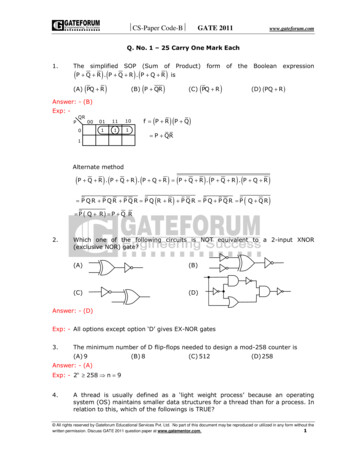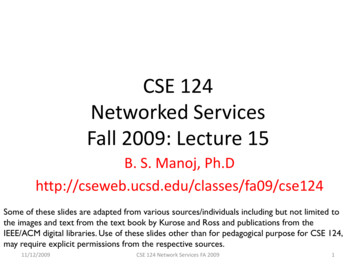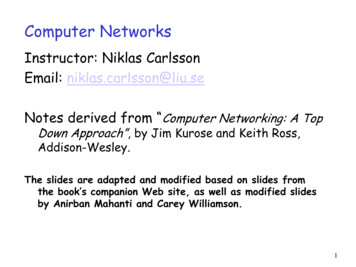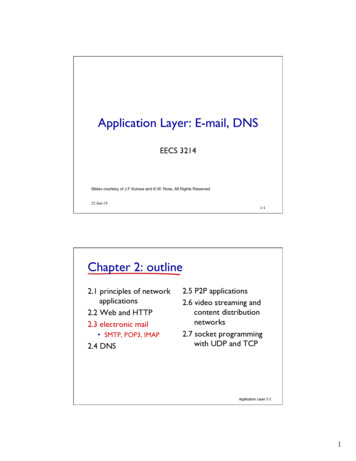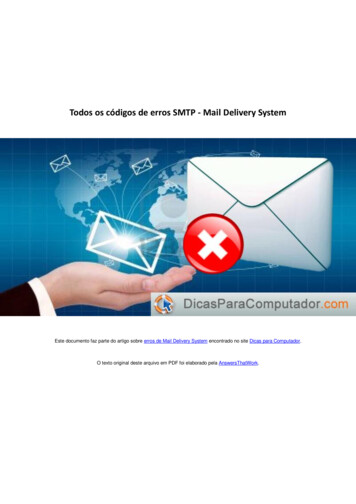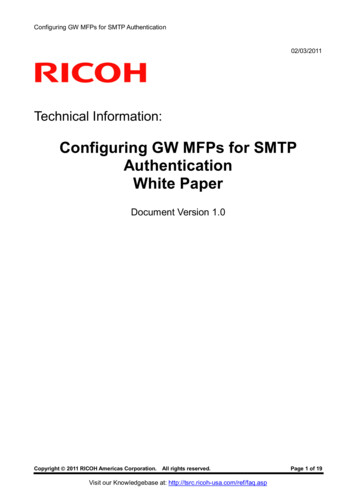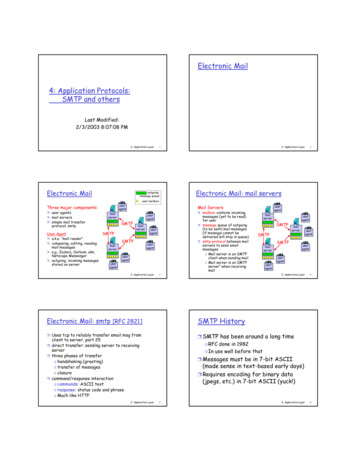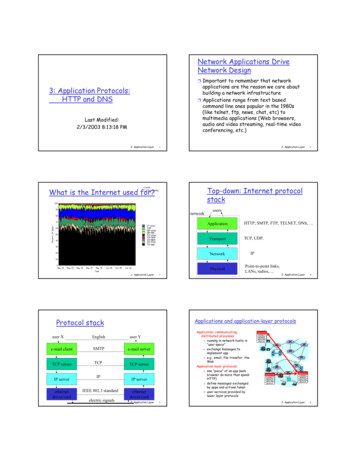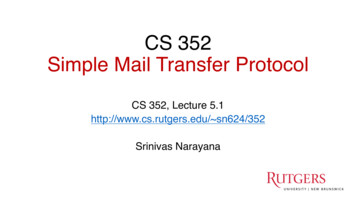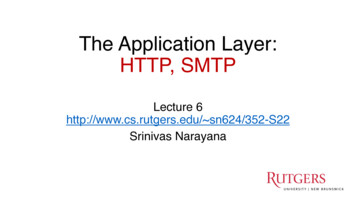
Transcription
The Application Layer:HTTP, SMTPLecture 6http://www.cs.rutgers.edu/ sn624/352-S22Srinivas Narayana1
Quick recap of conceptsHyperText Transfer Protocol (HTTP)App layerHTTP is a client/server applicationMethods: GET/POST/ HeadersUser-agent/server/ Response codes: 200, 404, etc.PersistenceCookiesConnectionRTT: XXXeikooSet-cinitiationCookie: XXXHTTP reqpRTT HTTP resCookie fileCachinge.g., proxyserver
Web cachesWeb caches: Machines that remember web responses for a networkWhy cache web responses? Reduce response time for client requests Reduce traffic on an institution’s access linkLast lecture: Caches implemented in the form of a proxy server3
Content Distribution Networks (CDNs)A global network of web caches Provisioned by ISPs and network operators Or content providers, like Netflix, Google, etc.Uses (overlaps with uses of web caching in general) Reduce traffic on a network’s Internet connection, e.g.,Rutgers Improve response time for users: CDN nodes are closer tomost users than origin servers Reduce bandwidth requirements on content provider Reduce to maintain origin servers4
Clientsdistributedall over theworldDNSWithout CDNDOMAIN NAMEIP du128.112.132.86Cluster of Rutgers CS originservers (located in NJ, USA) Problems: Huge bandwidth requirements for Rutgers Large propagation delays to reach users128.6.4.25
Where the CDN comes in Distribute content of the origin server over geographicallydistributed CDN servers But how will users get to these CDN servers? Use DNS! DNS provides an additional layer of indirection Instead of returning IP address, return another DNS server (NS record) The second DNS server (run by the CDN) returns IP address to client The CDN runs its own DNS servers (CDN name servers) Custom logic to send users to the “closest” CDN web server
Dr e NSplyWith CDNNS record delegates thechoice of IP address tothe CDN name server.PopularCDNs:CloudFlareAkamaiLevel3 12.1.2.312.1.2.6CDN serversDOMAIN NAMEIP 4.8.9.8 (NS record pointingto CDN name server)www.google.com74.125.225.243CDN Name Server (124.8.9.8)DOMAIN NAMEIP 2.412.1.2.5Customlogic tomap ONEdomainname toone ofmany IPaddresses!128.6.4.2Origin serverClientMost requests go to CDN servers (caches).CDN servers may request object from originFew client requests go directly to origin server
Summary of HTTP Request/response protocol ASCII-based human-readable message structures Improve performance using connection persistence,caching, and CDN Enhanced stateful functionality using cookies Simple, highly-customizable protocol Just add headers Protocol that forms of the basis of the web we enjoy today!8
Simple Mail Transfer Protocol10
We’re all familiar with email.How does it work?
outgoingmessage queueElectronic Mailuser mailboxuseragentThree major components:1. User agents a.k.a. “mail reader”mailserveruseragentSMTPe.g., Applemail, OutlookSMTP Web-based user agents (ex: eragentuseragent12
Electronic Mail: Mail servers2. Mail Servers Mailbox contains incoming messages foruser Message queue of outgoing (to be sent)mail messages Sender’s mail server makes connectionto Receiver’s mail serveruseragentmailserverSMTPSMTP IP address, port 253. SMTP protocol: client/server protocol Used to send messages Client: sending user agent or sendingmail server server: receiving mail eragentuseragentuseragent13
Scenario: Alice sends message to Bob4) SMTP client sends Alice’smessage over the TCPconnection5) Bob’s mail server places themessage in Bob’s incomingmailbox1) Alice(alice@rutgers.edu) usesUA to compose message tobob@nyu.edu2) Alice’s UA sends message toher mail server; messageplaced in outgoing messagequeue3) Client side of SMTP opensTCP connection with Bob’smail server1AliceA set of durable fileson the machine.Persisted on disk.useragent2mailserver3Rutgers mail server6) Sometime later, Bob invokeshis user agent to readmessagemailserver456NYU mail serveruseragentBob14
Observations on these exchanges Mail servers are the “infrastructure” for email functionality Receiving the email on behalf of Bob, should Bob’s machine be turned off Retrying the delivery of the email to Bob on behalf of Alice, should Bob’smail server be unavailable in the first attempt The same machine can act as client or server based on context Rutgers’s mail server is the server when Alice sends the mail It is the client when it sends mail to Bob’s mail server SMTP is push-based: info is pushed from client to server Contrast to HTTP or DNS where info is pulled from the server
Sample SMTP interaction telnet mail-server 25 HELO sender-domain MAIL FROM: name @ sender-domain RCPT TO: user @ mail-server-domain DATA Put data in, then [enter].[enter] Don’t forget the “.” You can add mail headers (later) to make your email look good
MAIL command response codes220: Service ready250: Request command complete354: Start mail input421: Service not available500: Unrecognized command17
Mail message format (stored on server)SMTP text message exchangestandardized in RFC 822 Header lines, e.g., To: From: Subject:These are different from SMTPcommands!(these would still be under“DATA”)headerblanklinebody body the “message”. ASCII characters only18
Message format: multimedia extensions MIME: multimedia mail extension, RFC 2045, 2056 additional headers in DATA header declare MIME content type A message can have many partsMIME versionmethod usedto encode datamultimedia datatype, subtype,parameter declarationencoded dataFrom: alice@crepes.frTo: bob@hamburger.eduSubject: Picture of yummy crepe.MIME-Version: 1.0Content-Transfer-Encoding: base64Content-Type: image/jpegbase64 encoded data .base64 encoded data19
Mail Access Protocols
Mail access protocolsSMTPAliceSMTPuseragentsender’s mailserverPOP3 or IMAP4access userprotocol agentBobreceiver’s mailserver SMTP: delivery/storage to receiver’s server. Focused on push Mail access protocol: retrieval from server POP: Post Office Protocol [RFC 1939] Client connects to POP3 server on TCP port 110 IMAP: Internet Mail Access Protocol [RFC 1730] Client connects to TCP port 143 HTTP: gmail, outlook, etc.27
POP vs IMAP POP3 Stateless server UA-heavy processing UA retrieves email fromserver, then typically deletedfrom server Latest changes are at the UA Simple protocol (list,retr, del within a POPsession) IMAP4 Stateful server UA and server processing Server sees folders, etc. whichare visible to UAs Latest changes are at the server Complex protocol Heavily used: email sync acrossdevices, reliable, 28
What about web-based email? Connect to mail servers via web browser Ex: gmail, scarletmail, etc. Browsers speak HTTP Email servers speak SMTP Need to bridge these two29
Web based emailHTTPAlicealice@scarletmail.rutgers.eduMay run on thesame or differentmachines(owned by yourwebmail provider)Application processon the web servermachine uses SMTPto push mailHTTPBobHTTP serverscarletmail.rutgers.eduHTTP serveroutlook.comApp process on the webserver uses accessprotocol to pull �s mailprovider’s server(s)SMTP mBob’s mailprovider’s server(s)IMAPBobbob@outlook.com30
Comparing SMTP with HTTP HTTP: pull SMTP: push both have ASCII command/response interaction, status codes HTTP: each object encapsulated in its own response msg SMTP: multiple objects sent in multipart msg HTTP: can put non-ASCII data directly in response (dedicatedentity body for binary data) SMTP: need ASCII-based encoding (base64)31
More themes from app-layer protocols Keep it simple until you really need complexity Start with ASCII-based design; stateless servers. Then introduce:Cookies for HTTP stateStateful mail (IMAP, folders, etc.) for email organizationSecurity extensions (e.g., TLS)Performance optimizations: persistence, caching, indirection, Use headers as much as possible to non-intrusively evolve functionality Partition functions based on what’s done best at the user (app) andprotocol. Examples: Content rendering for users (browser, UA) separate from protocoloperations (mail server) mail UA doesn’t need to be “always on” to send or receive email reliably.That’s the mail server’s job32
Comparing SMTP with HTTP HTTP: pull SMTP: push both have ASCII command/response interaction, status codes HTTP: each object encapsulated in its own response msg SMTP: multiple objects sent in multipart msg HTTP: can put non-ASCII data directly in response (dedicated entity body for binary data) SMTP: need ASCII-based .


